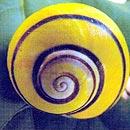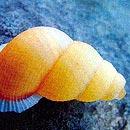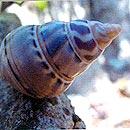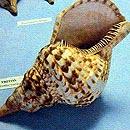Snails and Shells Coffers of wonders
Tiny drops of seawater sprinkle the feet. The eyes meet a quasi-buried object that glows a light of its own after resting on the hand for awhile. Picking up snails and seashells is both a recurrent and reference job when it comes to illustrating what a happy stay by the sea is really all about.
As hackneyed as it might appear, it usually proves right. Reaching out the arms and scouring randomly through the powder-thin sand is like a knee-jerk movement of relaxation quite similar to traipsing down miles of seashore strips and filling up pockets and hats of small, big, gaudy and white shells.
Trekking around the Caribbean's regions where gastropod mollusks coexist is kind of a master class of zoology because even though the Indian Ocean is a haven for this type of marine life, the so-called Antilles Province stretching out from Florida to the coasts of South America doesn't lag behind, either.
That human mechanism whereby an object is linked to another allows us to compare a Cyprea cervers with the gilt fur of a camel, while some Quincontes or Cassidaes bring back memories of checkered shirts. When it comes to appetizers, nothing compares to delicious olives, and that's how the Oliva reticularis Lamarck look like, whose shell patterns resemble trawling fishnets.
The coastlines of Cuba, Santo Domingo, Guadeloupe and the northern shore of Mexico, Nicaragua, Costa Rican and Colombia speak volumes of the diversity and beauty of these hard, firm and many-shaped creatures that could either render a token of friendship or be culled in private collections. They are the shelters of soft-body marine mollusks.
They've been there every step of the way and their timely findings have allowed mavens to trace back the Cambric period and especially the Cenozoic era because gastropods did us one better in populating the Earth regardless of geographical regions and planetary ecosystems. The tropics know their existence pretty well.
Despite the fact that their major attraction lies in their calcareous outer designs known as shell, it'd be unfair not to be aware of the living critter living inside: a mollusk whose well-defined head sports a couple of eyed feelers. Their astonishing moving power relies on their only muscled foot that comprises a great deal of energy and locomotion through a series of waving muscular contractions.
These little creatures whet the exotic appetite of those who love escargots, a delicatessen of the French cuisine usually bred on the ground, or the queen shell of the Caribbean Sea.
The Cittarium Pica Linneo, known as cigua and virtually killed off in Florida, dwells in the rocky coastlines of the West Indies. This excellent live bait described by anglers as an underwater magnet, makes fishermen's delight for the many recipes of rice and cigua that can be washed down with schooners of icy beer.
Borderlines of Sounds and Nacres All the Caribbean tawdriness seems to be enclosed in shells. The crimson rising sun, the yellowish sands, the bluish sky when night closes in. The nearly 200-mm-long Strombus gallus linneo is shaped in the form of a rooster's comb and its inner sound takes after the soft whispering of the waves. It's possible to pick it up all along the many miles between Florida and Brazil.
It's hard to trace in time who was the first human ever to put a conch next to his ears, yet you bet that was never child's stuff, but rather ingrained curiosity to ferret out what natural prodigy was hidden inside that big shell. The Cassis Tuberosa Linneo carries all the energy of the waters or the distant call of both tritons and mermaids. Its long and brownish look makes people wonder if it's more of a ground than a marine species. Its sound, though, is highly coveted by experts and neophytes alike.
The inner sound of the huge shells found at the beaches by Taino Indians on the Caribbean islands or the Arawaks all along the mainland's southern strip, drove those primitive dwellers in the region to give mollusks' shells a much better use. Their tubular shape and their incredible resonance probably turned shells into the very first musical instruments of the New World.
We know now that in Cuba, the Strombus gigas linneos, commonly known as ordinary conch, was tapered off in one of its tips and was then ready to convey messages through long distances.
In his master work entitled The Hurricane, Its Mythology and Its Symbols, Cuban scholar Fernando Ortiz provides an early view of the Caribbean and American cosmos in which the combined fury of the sea and the wind –an unexplainable phenomenon at the time- was usually portrayed in the shape of the conch.
There was always an imaginative association with the spiral morphology of the conch and that of a swirling hurricane or waterspout. Yet that was not the end of the linkage. These huge seashells were also viewed as sacred objects by the Aztecs.
For Quetzaltcoalt, they symbolized power within a magic and religious purpose. No wonder they are now dug out in the ruins of some major archeological sites of that important American civilization, as well as in other sightseeing, historic, tourist and cultural locations.
The Tecciztli (an indigenous term meaning great shell) was for years the symbol of the moon, let alone being an good-blaring trumpet. In the same breath, the Indians of the Orinoco River used to see spiritual usefulness in them and included conches in their religious rituals.
On the other hand, the West Indies' Guanajatabey and Auanabey Indians used to pulverize conches and wrap the resulting ground powder with the tobacco leaves they inhaled. The combination was said to trigger ecstasies and hallucinations of the behiques (witches and imps).
Closely linked to the gastropods for being also mollusks sheltered by a shell of calcium carbonate or phosphates, bivalves like oysters and mussels are part of the marine life that inhabits coral reefs and tropical beaches. Taking a logical account of their denomination, they are made up of two protective layers, sometimes thick like igneous material and sometimes thin like bright wax or French porcelain of Limouge.
Despite the great variety of these species in the Caribbean, we cannot dare say the region's bivalves are superb producers of pearl, that sought-after piece so widely used in jewelry everywhere under the sun. However, the shell lodger does produce eye-catching nacre layers, though it doesn't hold a candle to the pearls found in Japan or the Persian Gulf.
The domed Amunsiun Laurenti is no second-best to the best jewel piece crafted by an able-handed artisan. The edges of these two shells are well lined up and when they are closed is almost impossible to pry them open without splintering them.
On the other hand, when the Asaphis deflorata linneo opens up its two halves, it seems to flutter like a yellowish purple-spotted butterfly. And its black thorny heart is no other than the Trachycardium muricatum linneo, whose perennial mourning matches scarily against its white-yellowish innards.
All these bivalves are shy to the touch, as put by many a shell collector who sometimes defrays huge sums of money for just sliding his fingers down surfaces as smooth as a baby's bottom.
The Rosario Nature Coral Park in Colombia with 119,506 acres, embraces the country's largest underwater park and an admirable submerged extension that comprises 30 islets and keys. Visitors here look not only for scuba diving adventures. Beach shells and snails make many of them go oh and ah.
The keys of Cuba's Jardines del Rey also make tourists utter jaw-dropping exclamations. And what can we say of El Macao Beach in the Dominican Republic, penciled in by UNESCO as one of the finest in the Caribbean? Its name –El Macao (The Macaw)- can't be any closer to mollusks. Macaws are opportunist soft-body crabs that need an armor because they are unable to make a shelter for themselves, so they lay their claws to whatever empty shell is washed ashore by riptides.
Hinterland inhabitants Snail, little snail/get your feelers unveiled goes a nursery rhyme sung by our Spanish ancestors who after long hours of patient contemplation, learned ground mollusks are better fitted for moisture and shadows.
Cuban forests are inhabited by conspicuous species of Fasciatus and Zachrysia auricoma, that basically feed on the moss stuck on tree trunks. Therefore, shell collectors and sages believe they are excellent natural agents that play a useful role in the vegetal sanitation of those ecosystems.
They're usually brownish and exact black or dark stripes. For them, rainfall is a time of celebration and the much anticipated chance to launch out armies of colonies onto the stems and leaves of the surrounding trees.
This close encounter with nature, unlike the famous sun-and-beach modality, gives visitors the opportunity of trying their hands at both ecological and scientific tourism. To that aim, Cayo Santa Maria, off the northern coast of Cuba's Villa Clara, or the Grand Etang natural lake in Guadeloupe, stand for ideal reservoirs for vacationers to walk with magnifying glasses in their hands, take notes and make out (in Grand Etang), a Pomacea glauca.
But the one that really takes the cake is the polyamide, hailing solely from Cuba, or the motley pictus polyamide seen only in Baracoa, on the eastern side of the island nation. Some say no other mollusk shell aboveground, not even those dug out in the bottom of the Pacific Ocean, compare to the beauty and chromatic perfection of the Cuban polyamides. Their visual strength hinges on their pure shades of yellow, brown, red and blue.
These fabulous species are currently protected by the law because their haphazard collection in the past for decorative reasons dragged them to the brink of extinction, alongside the animal species that usually feed on them. A case in point is the Caguarero hawk that's been looked for to no avail in countless expeditions. With that exception in mind, Cuba is considered a paradise for shell collectors.
Ornamental keepsakes Each and every Caribbean nations has its own features and attractions that travelers by and large hunt down to take back home. Here's a useful recommendation: pay a visit to artisans' plazas and marketplaces.
In outdoors places frequently crammed with makeshift tables and shelves, hawkers sell miniature replicas of coral reefs and out-of-the-way conch lamps. More often than not, these objects wind up stuffed in several suitcases thanks to the peddlers' ability to put their items up for sale.
A similar fate awaits necklaces and earrings made of tiny bivalves and hued in delicate colors, as well as the coquina bracelets known locally as sea kidney beans because of their greenish shades.
The tonel cepa of the Lesser Antilles is more famous than its peers due to the pinkish semiprecious pearls it produces inside that often fare well in the market for they resemble fancy and pricey jewels.
Jamaica, Trinidad & Tobago and the Cayman Islands boast their Murex, that even in the raw and without any manmade modification, account for breathtakingly beautiful objects. There are jet-black Murex in the form of a nightly butterfly, and the Argo whose ornaments bear a resemblance to tree twigs.
Long before the discovery of the New World, snails and shells have struck people's attention. Quite recently, a variety of shells in great quantities was unearthed in Mayan burial sites in the Yucatan peninsula, Mexico. These findings proves the hypothesis that shell collection is by no means a modern hobby.
Pompousness, elegance and peerless beauty make us bat our eyes wide open in the face of snails and shells. It's simply impossible to brush off these coffers of wonders.
Scientific tourism is another way of making a close encounter with nature. Cayo Santa Maria, off the northern coast of Cuba's Villa Clara, or the Grand Etang natural lake in Guadeloupe, are ideal reservoirs for this purpose.
There was always an imaginative association with the spiral morphology of the conch and that of a swirling hurricane or waterspout, maybe inspired by the spiral lines and vibes.
Orishas (the African deities) are said speak or convey their messages through the Cyprea Moneta or Cauries, marine shells, or even through the ones dubbed cinturitas (thin waists). Evoking the power of divination, a priest from this religious syncretism reads 12 of 16 shells allowed by the ritual and the rich Oddum system of the Yorubas.
Depending on the way the shells fall, they can speak if they fall face up or they simply keep their mouths shut if they fall face down. If that's the case, worshipers are suggested to go see a babalao to find out what's wrong with that person.
Brought in from far-off Africa, local beliefs adapted themselves to the new way of life: slavery, a tragic episode that forced generations of men and women to protect their own cults and rites.
In Jamaica, Cuba, Brazil or voodoo-laden Haiti, the gods are represented by natural elements like stones and shells with a view to help and guide people through their daily lives.








































































